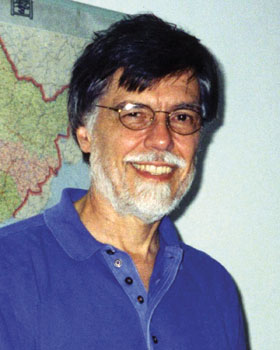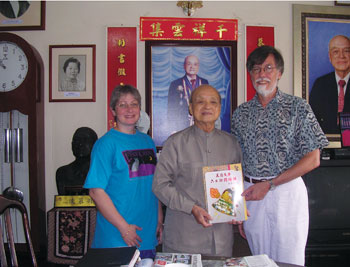The Hope of Friendly Learningby Jerry Dennerline ’64 |
| Printer-friendly version | Email this article |
|
How did a Hoosier boy with no Asian connections and whose parents never attended college become one of the world's jost respected explorers of China's past? I try to answer, but then follow up with questions for them. How did you get here? Where do you want to go after this? Why this little detour into the Chinese past on your way there? Invariably, the answers are both personal and philosophical. Together we learn some-thing new about our families, the cultures we live within and between, and something about how the recent and distant past matters in our lives. Among my own teachers are many amazing souls. One of them, known to his students as Yu Laoshi, died last month at the age of 105 in Taiwan, where I studied Chinese classics with him 40 years ago. Just last year colleagues more loyal and more thoughtful than I had presented him with a collage of photos and mementos collected from the rest of us. The photo of him seated regally in his straight-backed chair at that time brought on a rush of memories of those conversations about the deeper meanings of the texts, about his own youthful studies with some of China’s greatest scholars, and about his own life as a prince in the Manchu royal family through war, revolution, and years of exile in Taiwan. I shared the photo with my Amherst students who were just becoming aware of Yu Laoshi’s 17th-century ancestor, the great emperor Kangxi, who applied pragmatically the lessons he had learned from his teachers while memorizing those same Chinese classics. I was a graduate student in Taiwan in 1969, working in the palace museum library, when I first laid eyes on Qian Mu, the historian of Chinese thought and culture who was called “the nation’s teacher” by his admirers on the Nationalist side of the 1949 divide. Some 10 years later I was surprised to learn from one of his best- known students, then teaching at Yale, that the famous historian had begun his schooling as a poor widow’s son at the turn of the last century in a small town in Wuxi. The school was run by a lineage charitable estate that I happened to be studying at the time. At the age of 80, Qian Mu had begun writing his Memories of Teachers and Friends, starting with a moving reminiscence on his parents and the oral traditions of his own lineage in the village known as Qifangqiao, the place I called “Seven Mansions.” As I read it, he became my teacher as well, leading me on a new path of archival and oral history research back to his old home among the canals and rice paddies some 70 miles northwest of Shanghai. Twice, on my way there and back, I was privileged to meet him in Taiwan, where I asked him to tell me more about his own past. He asked me what I was learning in my explorations. We talked about China’s future, a conversation I continued to have in Shanghai with his nephew Qian Weichang, a renowned physicist who had gone the other way in 1949. The path these amazing teachers had set me on led deep into the world of toil and trouble from which they had emerged. In Wuxi’s small towns and villages my guide was a true product and free-thinking survivor of the revolution, a professor of history at Nanjing University whom I had met on my first trip to the People’s Republic in 1980. Lü Zuoxie taught me how to listen to old peasants and shopkeepers, country schoolteachers and specialists in funeral rites, poor tenant farmers and their learned but illiterate wives. He introduced me to the newer and older generations of local Communist Party secretaries and their advisors, asked them the critical questions that revealed many secrets and many statistics about rural development and educational reform. I tried to capture their voices and reproduce them as I retold the history of the place where Qian Mu was born and raised. I was then 20 years out of Wabash and newly tenured at Amherst, still feeling like a kindergartner in the larger school of life. At Amherst I soon met Lan Hua, who was to become my good friend and a teacher of another sort. He came to Amherst College as a graduate student at the University of Mas-sachusetts, struggling with student visa problems as he worked to build our Chinese language program from scratch. A survivor of the Cultural Revolution who loved Russian and English literature and had taught at a prestigious language institute in Beijing, he was a seeker of truth and an admirer of beauty who landed in New England and dedicated himself to teaching beginners how to speak, read, and write Chinese. He arrived in time to watch the events of spring 1989 [the Tianamen Square protests and government crackdown] from abroad. My own research plans were in ruins as a team of brilliant young scholars from Beijing, with whom a number of us were collaborating, scattered about the globe. Lan Hua and I spent the summer translating a group of Chi-nese journalists’ hastily assembled account of the Beijing Spring for one of the many collections that appeared the following year. From Lan Hua I learned humility as well as the meaning of loyalty and friendship across unimaginably broad cultural, political, and geographic divides, and I learned more about the joys and agonies of translating texts and cultures than I had known in my “kindergarten” years. I could say it started with Arthur and Mary Wright, eminent professors of Chinese history at Yale, survivors of Japanese POW camps in China and of the McCarthy hearings in the U.S. But how, after all, did I find them or they find me? As it turns out, I had the chance to read them as a student at Wabash. Who were my teachers back then? When I arrived at Wabash in 1960 Wendell Calkins H’59 had just taken a year’s break from English institutional history to study Chinese language and East Asian History at the University of Michigan. He introduced me to Chinese history and let me write a senior research paper in it. Perseverance, discipline, and accepting the limits of one’s skills and one’s sources, I learned, were essential parts of honest scholarship. Professor and American historian Steve Kurtz generously allowed me to pursue my growing interest in China, interest in his seminar on Jacksonian and Wilsonian democracy, and then taught me to beware the pitfalls of tunnel vision while burrowing in the archives. Then Jim Barnes came along and opened my eyes to the German psyche in the 1930s while transcending his own blindness as a teacher and a scholar, shaming those of us blessed with sight who ever entertained the thought of giving up a hard challenge. But none of my Wabash teachers was more influential in setting me on this path than the gentle and unassuming Wendell Calkins. He felt it was his responsibility to share what he had learned of the Chinese language during that year at Michigan. So he offered to introduce it to anyone willing to show up two evenings a week to sit around a table and go through the text with him. There I was along with two fellow students and three faculty members—Bert Stern, Richard Strawn, and Hall Peebles H’63—eagerly exploring a new world of sound and meaning. Studying a language like Chinese denies the tenses, the numbers, and even the gender in which you think—it challenges virtually everything you take for granted. After that twice-a-week experience, Wabash arranged a course in Chinese especially for two of us and taught by I write this as commencement approaches, after which I will leave for Malaysia and Singapore, where my research now focuses on teachers at Malacca’s Chinese vernacular schools in the 1920s and 1930s, many of whom were passing through on their way from somewhere in China to somewhere yet unknown to them. So long as we are eager to learn we will find our teachers, as Confucius said we would, whenever we are with two or more friends, our fellow learners. When they come “from afar,” they have that much more to teach us. When I return to Amherst, I will reflect again on how I went to Wabash because it seemed challenging but not so scary and foreign as a small college in New England seemed to me at the time. I found some great teachers there who had no more idea than I did where I was going after that. Having been somewhere else now, I am delighted to hear that the challenge remains, and the hope of friendly learning is alive. Jerry Dennerline is professor of Chinese history at Amherst College and is the author of Qian Mu and the World of Seven Mansions, the biography of one of the greatest historians and philosophers of 20th-century China, published by Yale University Press.
Lower Photo: Jerry Dennerline with his wife, Margaret Sarkissian, and Sim Mow Yu, 93-year-old founder of the Seng Cheong Night School and leader of the Malaysian Teachers Union, at his home in Meleka in 2006.
|

 As a teacher of Chinese history at Amherst College for the past 30 years, I have been privileged to meet many Chinese students who have taken the time to explore a bit of their country’s past with me. Often they have wondered aloud how I began my own exploration—why I decided to immerse myself in classical Chinese texts and late imperial history, how this could have led me into the small towns and villages of the lower Yangzi region during the exciting early years of the post-Mao reforms.
As a teacher of Chinese history at Amherst College for the past 30 years, I have been privileged to meet many Chinese students who have taken the time to explore a bit of their country’s past with me. Often they have wondered aloud how I began my own exploration—why I decided to immerse myself in classical Chinese texts and late imperial history, how this could have led me into the small towns and villages of the lower Yangzi region during the exciting early years of the post-Mao reforms. Over the past two decades a new generation of teachers and friends has emerged as I continue to follow the paths they open for me. The paths have led to Shanghai, Xiamen, Singapore, Malacca, and even to the University of Illinois and back to Indianapolis. But my students still wonder how I ever started this seemingly endless wandering through Chinese time and global space.
Over the past two decades a new generation of teachers and friends has emerged as I continue to follow the paths they open for me. The paths have led to Shanghai, Xiamen, Singapore, Malacca, and even to the University of Illinois and back to Indianapolis. But my students still wonder how I ever started this seemingly endless wandering through Chinese time and global space.